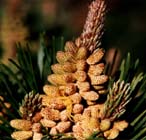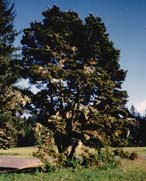
Trees growing in a peat bog on the Olympic Peninsula in Washington. P. contorta subsp. contorta is commonly found in bogs throughout its range [C.J. Earle, Apr-1999].

Active pollen cones of a specimen of subspecies contorta growing native at Patrick's Point, California [C.J. Earle, May-1999].

A specimen of subspecies contorta growing native at Patrick's Point, California [C.J. Earle, May-1999].

Two 3-5 m tall trees of subspecies contorta growing as ornamentals within their native range in Seattle (USA) [C.J. Earle, 19-Mar-1999].
Common Names
Lodgepole pine (1); beach, western scrub, north coast scrub, sand, shore or knotty pine (2).Taxonomic notes
Three subspecies: subsp. contorta, subsp. latifolia (Engelm.) Critchfield, and subsp. murrayana (Balfour) Engelmann. These taxa are sometimes treated at the rank of variety (3), but almost all researchers actively involved with study into the species recognise them at subspecific rank, observing the substantial genetic and adaptational differences between them (4, 5, 6, 7, 8, 9).A fourth taxon, the Mendocino Sands Shore pine, has also been recognised as a subspecies by some of these authors, as subsp. bolanderi (Parlatore) Critchfield, but other studies (7, 9) have shown that this is less distinct from subsp. contorta"The two subspecies [contorta, bolanderi] did not show the phylogenetic dichotomy in allozyme allelic constitutions expected for subspecific classification" (9), and it is recognised here as a variety within subsp. contorta, var. bolanderi (Parlatore) Koehne. Those who treat the main subspecies at varietal rank treat bolanderi as a synonym of contorta (3).
There is also genetic evidence that subsp. latifolia is separable into two populations, a southern one in the Rocky Mts south of the Pleistocene ice, and a northern one which suvived in ice-free areas (nunataks and larger areas too dry for icefield formation) north of the main ice front (6, 7); these could possibly be distinct at varietal rank but no name has been given to the northern population.
Description
Tree: Shrub or tree to 50 m tall and 90 cm dbh, straight to contorted, with crown varying according to genetic race; lower branches often descending, the upper spreading or ascending (3).Bark: Brown to gray- or red-brown, platy to furrowed, variable in thickness both between and within populations (3, 4).
Twigs: Slender, multinodal, rough, orange to red-brown, aging darker brown (3).
Leaves: Yellow-green to dark green, 2 per fascicle, spreading or ascending, persisting 3-8 years, 2-8 cm × 0.7-2(-3) mm, twisted, all surfaces with fine stomatal lines, margins finely serrulate, apex blunt to acute or narrowly acuminate; sheath 0.3-0.6(-1) cm, persistent. Buds narrowly to broadly ovoid, dark red-brown, to 1.2 cm, slightly resinous (3).
Pollen cones: Ellipsoid to cylindric, 5-15 mm long, orange-red (3).
Seed cones: Variably asymmetric, lanceoloid to ovoid before opening, broadly ovoid to globose when open, (2-)3-6(-7.5) cm long, tan to pale red-brown, lustrous, nearly sessile or on a peduncle to 2-3 mm long, maturing in 16-20 months, variably serotinous, variably persistent (3).
Cone scales: Apophyses nearly rhombic, variously elongate, cross-keeled, often mammillate toward outer cone base and on inside above middle; umbo central, depressed-triangular, prickle barely elongate to stubby or slender and to 6 mm (3).
Seeds: Compressed, obovoid; body ca. 5 mm, black (infertile seeds often mottled pale to red-brown), wing 10-14 mm. 2n=24 (3).
Range
W USA, W Canada, Mexico: Baja California Norte, at 0-3500 (-3900) m (4, 5). See also (11).Big Tree
See subsp. murrayana.Oldest
See subsp. murrayana.Dendrochronology
Ethnobotany
Observations
Remarks
"Pinus contorta is fire successional over most of its range and is characterized by prolific seeding and high seed viability in disturbed habitats, often resulting in extremely slow-growing, overly dense stands" (3).It has become naturalised in some areas including New Zealand, and more locally in Britain; in New Zealand this has become a serious problem adversely affecting native vegetation (papers in 10).
Although contradictory, both the Latin and common names accurately describe the species: members of subsp. contorta, first observed growing near the Pacific Ocean, are intricately contorted by the effects of wind and salt spray; while trees of subsp. latifolia, the commonest tree in Wyoming and much of the remainder of the Rocky Mountains, grow tall and slender, making them ideal material for the lodge-poles of Plains Indian tipis.
Citations
(1) Burns & Honkala 1990.(2) Peattie 1950.
(3) Robert Kral in Flora of North America online.
(4) W.B. Critchfield. 1957. Geographic variation in Pinus contorta. Maria Moors Cabot Foundation (Harvard) Publ. 3.
(5) N.C. Wheeler & R.P. Guries. 1982. Population structure, genic diversity, and morphological variation in Pinus contorta Dougl. Canad. J. Forest Res. 12: 595-606.
(6) N.C. Wheeler & R.P. Guries. 1982. Biogeography of lodgepole pine. Canad. J. Bot. 60: 1805-1814.
(7) N.C. Wheeler & W.B. Critchfield. 1985. The distribution and botanical characteristics of lodgepole pine: biogeographical and management implications. Pp. 1-13 in D.M. Baumgartner (ed.). Lodgepole pine: the species and its management. Pullman, WA: Washington State University.
(8) E. von Rudloff & M.S. Lapp. 1987. Chemosystematic studies in the genus Pinus. VI. General survey of the leaf oil terpene composition of lodgepole pine. Canad. J. Forest Res. 17: 1013-1025.
(9) S.N. Aitken & W.J. Libby. 1994. Evolution of the pygmy-forest edaphic subspecies of Pinus contorta across an ecological staircase. Evolution 48: 1009-1019.
(10) Richardson 1998.
(11) Robert S. Thompson, Katherine H. Anderson and Patrick J. Bartlein. 1999. Atlas of Relations Between Climatic Parameters and Distributions of Important Trees and Shrubs in North America. U.S. Geological Survey Professional Paper 1650 A&B. URL= http://greenwood.cr.usgs.gov/pub/ppapers/p1650-a/pages/conifers.html, accessed 22-Jan-2000.
See also:
Elias 1987.
Lanner 1983.
Little 1980.
FEIS database.
[Pinus] [Pinaceae] [home]
This page is from the Gymnosperm Database
URL: http://www.geocities.com/~earlecj/pi/pin/cont.htm
Edited by Christopher J. Earle
E-mail:earlecj@earthlink.com
Last modified on 24-Jan-2000